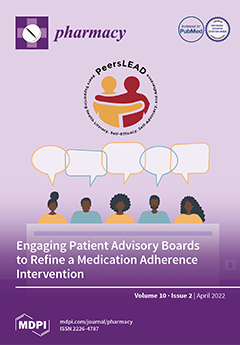Introduction: The patronage of online pharmacies is rapidly growing, driven by the convenience and cheaper costs of purchasing prescription drugs electronically, especially under the lockdown situation. However, there are issues regarding the quality of the prescription drugs sold online and the legitimacy
[...] Read more.
Introduction: The patronage of online pharmacies is rapidly growing, driven by the convenience and cheaper costs of purchasing prescription drugs electronically, especially under the lockdown situation. However, there are issues regarding the quality of the prescription drugs sold online and the legitimacy of online pharmacies. The use of prescription drugs without the supervision of a licensed health care practitioner may potentially harm consumers.
Objectives: This systematic review was conducted to improve the body of knowledge on three main aspects of online pharmacies: (1) type and characteristics of the online pharmacies selling drugs; (2) the quality of pharmaceutical drugs purchased online; and (3) the characteristics of consumers of online pharmacies.
Methods: Based on a pre-defined search strategy, PubMed and Scopus were utilised to search articles written in the English language published between January 2009 and February 2020. Studies focusing on the sale of prescription drugs were included. The terms used for the literature search were “online pharmacy”, “internet pharmacy”, “e-pharmacy”, “prescription”, “quality”, “medication safety”, and “counterfeit medicine”. These terms were used alone and in combination with Boolean operators. The institutional webpages including the World Health Organization (WHO) and the United States Food and Drug Administration (USFDA) were also examined for any additional studies. No methodological limitations in terms of study design were applied. A standardised data collection form was used to compile the data.
Results: Based on the inclusion and exclusion criteria, a total of 46 articles were eligible and included in the final analysis. There were 27 articles on types and characteristic of online pharmacies, 13 articles on the quality of prescription drugs sold from online pharmacies, and 11 articles on consumers purchasing prescription drugs from online pharmacies. Readers should note that five articles discussed both the types and characteristics of online pharmacies, and the quality of the drugs sold from the outlets. The response rate (products received out of the number of orders) ranged from 20% to 100%, whereas the proportion of consumers buying prescription drugs online ranged from 2.3% to 13%. Reasons for online purchase of prescription drugs include the difficulty of obtaining a prescription for certain medications such as opioid analgesics, cheaper cost, since the costs associated with seeing a physician to obtain a prescription are reduced, and the need to obtain drugs such as opioid analgesics and benzodiazepine for misuse.
Conclusions: Almost half of the online pharmacies are not properly regulated and fraudulent issues were uncovered. To address this issue, stricter regulation by World Health Organization and implementation should be carried out together with frequent monitoring of the licensure system and pharmacy verification on every online pharmacy, this would reduce the number of illegal or illegitimate online pharmacy.
Full article





